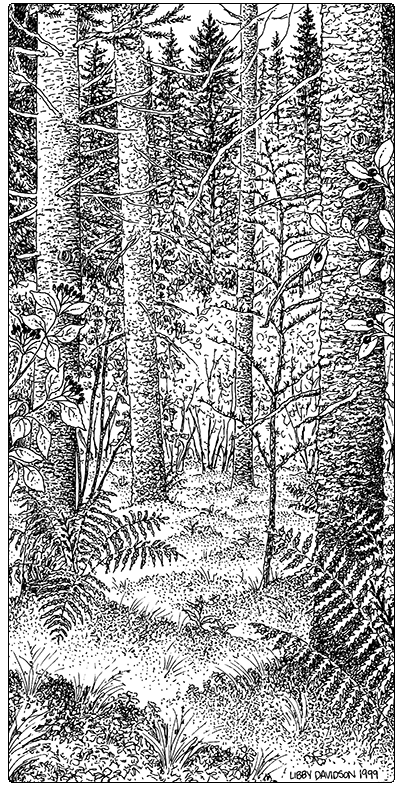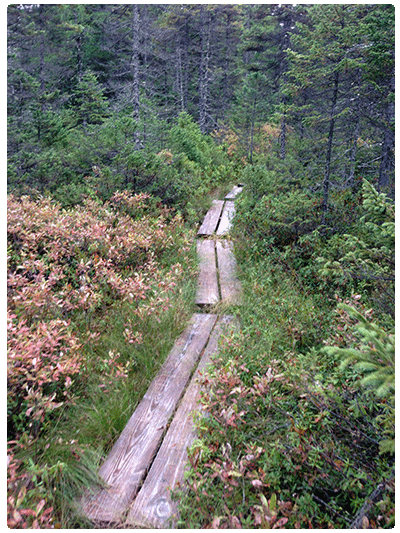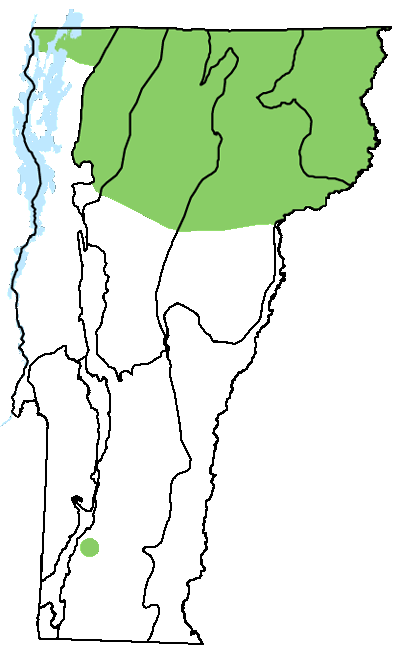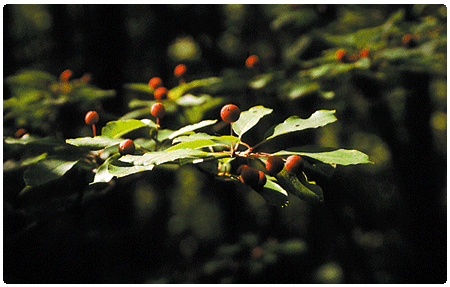Ecology and Physical Setting 
Cold, wet, mossy, and verdant, Spruce-Fir-Tamarack Swamps harken to the boreal north. Walking into one of these swamps, with their spruce spires and boreal birds, it is easy to imagine oneself in the wild regions of Labrador. These swamps occur in the colder regions of the state, often in basins with cold air drainage. They may occur in isolation from other wetland types or as part of larger wetland complexes. When occurring in streamside wetland complexes, Spruce-Fir-Tamarack Swamps occupy areas that do not receive flooding or nutrient enrichment from adjacent streams. These swamps range in size from just a few acres to over 100 acres.
Spruce-Fir-Tamarack Swamps have peat soils that are saturated throughout the year due to impeded drainage. These organic soils are variable in depth. The soils and water are acidic, but there can be minor mineral enrichment from surface water runoff or from groundwater seepage near the swamp margins. Spruce-Fir-Tamarack Swamps are associated with acidic bedrock and surficial deposits. The relative abundance of tamarack and red spruce in these swamps is likely related to the degree of mineral enrichment, with abundant tamarack possibly indicating more enrichment. Tamarack is also very shade intolerant and may be more abundant in early to mid-successional examples of this community type. Spruce-Fir-Tamarack Swamps commonly grade into Black Spruce Swamps as peat becomes deeper, and there is greater isolation from surface runoff and the underlying mineral soils.
Wind is the primary source of natural disturbance, tipping the shallow-rooted trees and creating canopy openings. As with other forested wetlands that may occur near streams, beaver impoundments may inundate portions of Spruce-Fir-Tamarack Swamps.
Vegetation
The interiors of Spruce-Fir-Tamarack Swamps have a distinct structure. The straight, vertical trunks of black and/or red spruce, balsam fir, and tamarack dominate the relatively closed canopy. There is a well-developed tall shrub layer of mountain holly and wild raisin, and a sparser low shrub layer that typically includes sheep laurel. In more boggy conditions, rhodora, Labrador tea, bog laurel, or leatherleaf may be present.
Mosses carpet the low hummocks and shallow hollows. Shreber’s moss —a ubiquitous species of the north—is common, along with knight’s plume moss, windswept mosses, and several species of sphagnum moss. The hollows seldom contain standing water. Scattered delicate herbs mix with tall ferns on the mossy hummocks. Three-seeded sedge, boreal bog sedge, cinnamon fern, three-leaved false Solomon’s seal, and creeping snowberry are among the characteristic species.
Wildlife Habitat

The evergreen canopies of Spruce-Fir-Tamarack Swamps provide winter cover for white-tailed deer. This cover is especially important in the deep-snow areas where these swamps occur. American marten and Canada lynx, both very rare in Vermont, may be found in Spruce-Fir-Tamarack Swamps and other spruce-fir forests of the Northeastern Highlands.
Spruce-Fir-Tamarack Swamps support many species of boreal birds that reach their southern range limits in northern Vermont. These species include black-backed woodpecker, American three-toed woodpecker, Canada jay, boreal chickadee, and spruce grouse. The yellow-bellied flycatcher is another boreal species that breeds in these swamps. It is our only ground-nesting flycatcher, building its well-hidden, grass and moss lined nest among sphagnum or tree roots. More common breeding birds include Canada warbler, olive-sided flycatcher, northern waterthrush, Nashville warbler, Blackburnian warbler, and both the ruby-crowned and golden-crowned kinglets.
The clamp-tipped emerald and the rare Kennedy’s emerald—dragonflies more typically associated with open peatlands—may also be found in Spruce-Fir-Tamarack Swamps.
Related Communities
- Black Spruce Swamps are dominated by black spruce and typically have deeper organic soils and even less mineral enrichment. They commonly occur adjacent to and may grade into Spruce-Fir-Tamarack Swamps.
- Red Spruce-Cinnamon Fern Swamps typically lack black spruce, tamarack, and bog shrubs like Labrador tea and bog laurel. They have slightly more groundwater flow and can contain seepage indicators.
Conservation Status and Management Considerations
Because of their sensitive peat soils, logging is not recommended in Spruce-Fir-Tamarack Swamps. Several excellent examples occur on state and private conservation land.
Distribution/Abundance 
Spruce-Fir-Tamarack Swamps occur throughout northern New York and New England, southern Québec, and the Maritime Provinces. Similar communities also occur in the Appalachian Mountains to the south. In Vermont, these swamps are found in the cooler climate areas, primarily in the northern part of the state.
Characteristic Plants
Trees
Abundant Species
Red spruce – Picea rubens
Balsam fir – Abies balsamea
Tamarack – Larix laricina
Occasional to Locally Abundant Species
Black spruce – Picea mariana
Northern white cedar – Thuja occidentalis
Shrubs
Abundant Species
Mountain holly – Ilex mucronata
Wild raisin – Viburnum nudum var. cassinoides
Sheep laurel – Kalmia angustifolia
Occasional to Locally Abundant Species
Rhodora – Rhododendron canadense
Labrador tea – Rhododendron groenlandicum
Bog laurel – Kalmia polifolia
Leatherleaf – Chamaedaphne calyculata
Velvetleaf blueberry – Vaccinium myrtilloides
Herbs

Spruce-Fir-Tamarack Swamps.
Abundant Species
Three-seeded sedge – Carex trisperma
Cinnamon fern – Osmundastrum cinnamomeum
Three-leaved false Solomon’s seal – Maianthemum trifolium
Canada mayflower – Maianthemum canadense
Creeping snowberry – Gaultheria hispidula
Occasional to Locally Abundant Species
Boreal bog sedge – Carex magellanica
Hoary sedge – Carex canescens
Bluebead lily – Clintonia borealis
Crested wood fern – Dryopteris cristata
Whorled aster – Oclemena acuminata
Twinflower – Linnaea borealis
Bunchberry – Cornus canadensis
Bryophytes
Abundant Species
Moss – Sphagnum girgensohnii
Moss – Sphagnum angustifolium
Schreber’s moss – Pleurozium schreberi
Occasional to Locally Abundant Species
Knight’s plume moss – Ptilium cristacastrensis
Moss – Sphagnum wulfianum
Windswept moss – Dicranum spp.
Three-lobed bazzania – Bazzania trilobata
Moss – Aulacomnium palustre
Rare and Uncommon Plants
Mountain fly honeysuckle – Lonicera villosa
Dwarf mistletoe – Arceuthobium pusillum
Moose dung moss – Splachnum ampullaceum
Associated Animals
Moose – Alces americanus
White-tailed deer – Odocoileus virginianus
Red squirrel – Tamiasciurus hudsonicus
Southern red-backed vole – Myodes gapperi
Masked shrew – Sorex cinereus
Snowshoe hare – Lepus americanus
Canada warbler – Cardellina canadensis
Olive-sided flycatcher – Contopus cooperi
Northern waterthrush – Parkesia noveboracensis
Yellow-rumped warbler – Setophaga coronata
Nashville warbler – Oreothlypis ruficapilla
Blackburnian warbler – Setophaga fusca
Northern parula – Parula americana
Magnolia warbler – Dendroica magnolia
Ruby-crowned kinglet – Regulus calendula
Golden-crowned kinglet – Regulus satrapa
Clamp-tipped emerald – Somatochlora tenebrosa
Rare and Uncommon Animals
American marten – Martes americana
Canadian lynx – Lynx canadensis
Yellow-bellied flycatcher – Empidonax flaviventris
Black-backed woodpecker – Picoides arcticus
American three-toed woodpecker – Picoides dorsalis
Spruce grouse – Falcipennis canadensis
Canada jay – Perisoreus canadensis
Cape May warbler – Setophaga tigrina
Bay-breasted warbler – Setophaga castanea
Boreal chickadee – Poecile hudsonicus
Rusty blackbird – Euphagus carolinus
Northern saw-whet owl – Aegolius acadicus
Red crossbill – Loxia curvirostra
Kennedy’s emerald – Somatochlora kennedyi
Places to Visit
Nulhegan Basin, Lewis, Silvio O. Conte National Fish and Wildlife Refuge, U.S. Fish and Wildlife Service
Wenlock Wildlife Management Area, Ferdinand, Vermont Fish and Wildlife Department (VFWD)
Victory Basin Wildlife Management Area, Victory, VFWD
Bill Sladyk Wildlife Management Area, Norton and Holland, VFWD
Groton State Forest, Marshfield, Vermont Department of Forests, Parks, and Recreation
Bear Swamp, Wolcott, Sterling College
